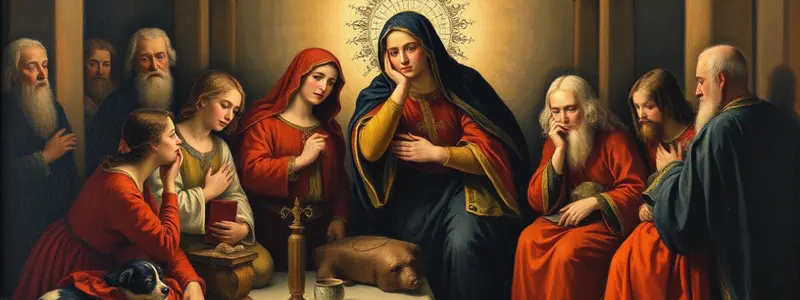Podcast
Questions and Answers
What is primarily centered in popular piety according to the content?
What is primarily centered in popular piety according to the content?
- The Word of God
- The practice of rites (correct)
- Sacramental worship beyond baptism
- Doctrinal understanding
Which of the following best describes the way God revealed Himself in the Old Testament?
Which of the following best describes the way God revealed Himself in the Old Testament?
- Exclusively through prophetic teachings
- Through legislation only
- Through both deeds and words (correct)
- Through signs composed only of words
In the context of faith, what does 'faith as entrusting' primarily reflect?
In the context of faith, what does 'faith as entrusting' primarily reflect?
- Manifesting actions through rituals
- Acknowledging the existence of God
- Hoping for mercy and redemption (correct)
- Understanding doctrines
According to the lesson regarding the prodigal son, what should believers do to reflect their understanding of mistakes?
According to the lesson regarding the prodigal son, what should believers do to reflect their understanding of mistakes?
What is a key aspect of love according to the content?
What is a key aspect of love according to the content?
Which description best fits the idea of 'faith as doing'?
Which description best fits the idea of 'faith as doing'?
What does the phrase 'threefold mission' refer to in the context?
What does the phrase 'threefold mission' refer to in the context?
What does Augustine encourage regarding the mercy of God in the context of the prodigal son?
What does Augustine encourage regarding the mercy of God in the context of the prodigal son?
Which of the following themes is NOT commonly associated with Philippine oral literature?
Which of the following themes is NOT commonly associated with Philippine oral literature?
Which of the following works is attributed to Jose Rizal?
Which of the following works is attributed to Jose Rizal?
What literary form is characterized by brief narratives that deliver a moral lesson and often feature animals?
What literary form is characterized by brief narratives that deliver a moral lesson and often feature animals?
Which of the following is NOT a characteristic of flash fiction?
Which of the following is NOT a characteristic of flash fiction?
In Philippine literature, who is the author known for the work 'Mother folklore'?
In Philippine literature, who is the author known for the work 'Mother folklore'?
Ano ang pangunahing kahulugan ng wika ayon kay Henry Gleason?
Ano ang pangunahing kahulugan ng wika ayon kay Henry Gleason?
Alin sa mga sumusunod ang hindi katangian ng wika?
Alin sa mga sumusunod ang hindi katangian ng wika?
Ano ang tawag sa pag-aaral ng mga morpema?
Ano ang tawag sa pag-aaral ng mga morpema?
Ano ang pangunahing layunin ng wika ayon kay Webster?
Ano ang pangunahing layunin ng wika ayon kay Webster?
Alin sa mga sumusunod ang mga elemento ng wika?
Alin sa mga sumusunod ang mga elemento ng wika?
Flashcards are hidden until you start studying
Study Notes
Lesson 1: Faith and Church
- Faith centers on believing in the God revealed by Jesus Christ.
- Christ reveals God through the Catholic Church, which is the body of Christ, united in the Holy Spirit.
- Many modern believers focus on popular piety rituals rather than the Word of God, doctrines, or sacramental worship.
- Types of belief:
- Fundamentalist: Emphasizes words over actions.
- Ideological: Focuses on actions without prayer.
- Individualistic: Relies on a laissez-faire attitude towards faith ("bahala na si lord").
Lesson 2: God's Revelation
- God reveals Himself through creation, scripture, and the Church.
- In the Old Testament, particularly in the letter to the Hebrews, God communicates through both deeds and words.
- Significant covenants established with Noah, Abraham, and Moses.
- God performed miracles for His Chosen People and conveyed truth through the prophets.
- Jesus gathered disciples to form the original nucleus of his Church.
Lesson 3: Love and Mission
- Love must encompass both love of God and love of neighbor, mirroring Christ's example.
- This love compels believers towards mission work.
- Believers are called to a threefold mission as priest, prophet, and king.
Lesson 5: Dimensions of Faith
- Faith is viewed in three dimensions:
- As believing: Inquiry into knowledge ("What can I know?") fostering maturity.
- As doing: Motivation for action ("What should I do?") encourages freedom.
- As entrusting: Focus on hope for the future ("What can I hope for?") nurtures spiritual joy.
Lesson 8: Reflection Questions
- What can I know?
- Augustine highlights the importance of understanding God's mercy and forgiveness, especially in the context of the Prodigal Son.
- What should I do?
- A call for repentance, acknowledging mistakes as exemplified by the Prodigal Son's journey.
- What may we hope for?
- Encourages believers to place hope in God's mercy and the redemption He offers.
Literature
- Comprises written works that express ideas, emotions, stories, and experiences.
Characteristics
- Reflects cultural identity and values of a society.
- Engages consumers emotionally or intellectually.
- Utilizes various forms and genres to convey messages.
Philippine Literature
- Rich and diverse, shaped by the country's history, culture, and languages.
Filipino
- Written primarily in native languages, reflecting local themes and issues.
Baybayin
- An ancient script used by pre-colonial Filipinos for writing.
- Holds historical significance in Philippine culture.
English
- Adopted during the American colonization period, influencing modern literature in the Philippines.
Present
- Continues to evolve with contemporary themes, styles, and socio-political issues.
Dimensions of Philippine Literary History
- Encompasses both oral and written traditions, each with distinctive characteristics and influences.
Oral Literature
- Integral in passing down cultural beliefs, values, and history through generations.
Written Literature
- Grew significantly during the Spanish and American colonial periods, producing notable literary works.
Oral Lore
- Includes traditional stories, ranging from legends to contemporary fables.
Riddles (Bugtong-Bugtong)
- Playful forms of oral literature used to challenge wits and entertain.
Proverbs (Salawikain)
- Concise expressions conveying wisdom, cultural morals, and life lessons.
Chants (Bulong)
- Short verses often used in rituals or for blessings, embodying cultural practices.
Folk Songs
- Reflects communal sentiments, traditions, and local histories, serving as a vital form of cultural expression.
Myths
- Narratives that explain natural phenomena and cultural beliefs, often featuring gods and legendary figures.
Epic
- Long narrative poems typically detailing heroic deeds, such as "Ibong Adarna."
Flash Fiction
- A brief storytelling format that utilizes economy of language while delivering impactful messages.
Short Story
- A concise fictional narrative focusing on a particular theme or character development.
Characteristics
- Typically under 7,500 words, allows for deep exploration of themes within limited space.
- Often portrays a single incident or idea.
- Focus on character and conflict rather than plot development.
Variation
- Emerges within many genres, adapting to socio-cultural contexts and reader preferences.
Fables
- Short stories that illustrate moral lessons, often featuring animals as characters.
Post-Colonial Fables
- Reflect awareness of colonial history and its impact, integrating original Filipino myths and stories.
Canonical Writers
- Carlos Bulosan, Francisco Balagtas, Jose Rizal, Nick Joaquin, NVM Gonzales, and other influential authors representing diverse regions and themes.
Annotation
- Detailed analysis of significant literary works, exploring themes, character development, and context, aiding comprehension and appreciation.
Key Literary Works and Authors
- "My Father Goes to Court" by Carlos Bulosan - explores familial relationships and justice.
- "Florante at Laura" by Francisco Balagtas - a classic romantic epic in Tagalog.
- "Eli Fili at Noli Me Tangere" by Jose Rizal - critiques colonialism and social injustices.
- "May Day Eve" by Nick Joaquin - delves into the complexities of love and memory.
- "Bread of Salt" by NVM Gonzales - a coming-of-age story in Filipino culture.
- "Sarung Banggi" by Portencio Gregorio Sr. - reflects regional musical traditions.
- "Magdalena" by Cecilia Manguera-Brainard - explores women’s roles and societal expectations.
- "Mother Folklore" by Damiana L. Eugenio - a collection celebrating Filipino folklore.
- "Love in Corn Husks" by Aida Rivera Ford - intertwines themes of love and cultural identity.
- "Philippine Item" by Julian Felipe - patriotic themes linked with cultural identity.
- "Bayan Ko" - a notable patriotic song representing Filipino nationalism.
Definition of Language
- Language is a systematic framework comprising symbols, sounds, and rules for expression.
- Influences originate from ancestors and serve as a foundation for understanding and unity.
Key Definitions from Scholars
- Henry Gleason: Defines language as a structured system of spoken sounds.
- Hemphill: Describes language as a symbol representing collective agreement.
- Sapiro: Views language as a natural, human method for conveying messages.
- Webster: Considers language a tool for achieving mutual understanding.
Characteristics of Language
- The study of morphemes falls under morphology, focusing on the structure of words and their meaningful components.
Theories of Language Origin
- Several theories exist to explain the origins of language, emphasizing varied perspectives on how language developed.
Variations of Language
- Language reflects aspects of culture, history, and social differences, illustrating diversity within communication systems.
Levels of Language
- Language can be categorized into various levels, indicating its complexity and adaptability in different contexts.
Official Languages
- Official languages are designated for governmental and formal use, guiding communication in public affairs and institutions.
National Language
- The national language serves as a unifying linguistic identity for a country, promoting cultural and social cohesion among its citizens.
Studying That Suits You
Use AI to generate personalized quizzes and flashcards to suit your learning preferences.




